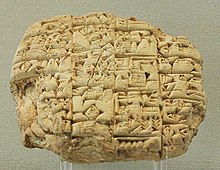Written down languages........................rather than spoken.......math might have been first......................
Proto-literate period[edit]
The cuneiform script proper developed from pictographic proto-writing in the late 4th millennium B.C.E. Mesopotamia's "proto-literate" period spans roughly the 35th to 32nd centuries. The first documents unequivocally written in the Sumerian language date to c. the 31st century, found at Jemdet Nasr.
Originally, pictographs were either drawn on clay tablets in vertical columns with a sharpened reed stylus, or incised in stone. This early style lacked the characteristic wedge shape of the strokes.
Certain signs to indicate names of gods, countries, cities, vessels, birds, trees, etc., are known as determinatives, and were the Sumerian signs of the terms in question, added as a guide for the reader. Proper names continued to be usually written in purely "logographic" fashion.
The earliest known Sumerian king whose name appears on contemporary cuneiform tablets is Enmebaragesi of Kish. Surviving records only very gradually become less fragmentary and more complete for the following reigns, but by the end of the pre-Sargonic period, it had become standard practice for each major city-state to date documents by year-names commemorating the exploits of its lugal (king).
From about 2900 B.C.E., many pictographs began to lose their original function, and a given sign could have various meanings depending on context. The sign inventory was reduced from some 1,500 signs to some 600 signs, and writing became increasingly phonological. Determinative signs were re-introduced to avoid ambiguity. Cuneiformwriting proper thus arises from the more primitive system of pictographs at about that time (Early Bronze Age II).
Archaic cuneiform[edit]
Further information: Liste der archaischen Keilschriftzeichen


No comments:
Post a Comment